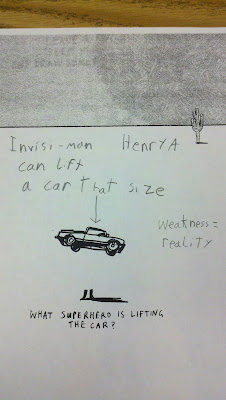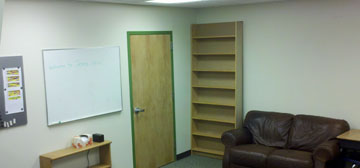I intend to update our class blog regularly with summaries and extensions of our classroom activities. As you might imagine, the first week of school was a bit of a whirlwind, so blogging quickly fell by the wayside. Now that things have settled down a bit, I'd like to give you an overview of how we spent our first week.
Fair warning: I sometimes err on the side of too much information. It's partially to give you a really good sketch of our week, but also because I find it helps me to reflect on where we've been to better inform where we're going. That said, I apologize if this is too much information all at once! In the future, I intend to break things up a bit to make them more digestible. Your feedback on this front would be much appreciated! Let me know what you'd like more or less of!
Tuesday, September 4:
We began our day with all-school assembly. Joanna welcomed us to both the new school year and our new building, which yielded many rounds of applause. After a quick round of staff introductions, we all went to our separate classrooms to get to know one another. Here's our regular Tuesday schedule, with a few notes regarding how we actually spent our time:
8:45 -
Homeroom
9:00 -
Math: We skipped math today in favor of a "welcome to the classroom" conversation.
10:00 -
Snack/recess: Rain kept us indoors, but students still enjoyed games, drawing, conversation, and exploring our classroom library.
10:35 - Music (be sure to visit
Cara's Music Blog!)
11:30 - Recess/Lunch
12:30 - PE
2:20 - Homeroom
2:45 - French/Mandarin
3:30 - Dismissal!
As you can see, Tuesdays are packed with specialty classes, so we had precious little homeroom time. Most of that was spent talking as a group about our classroom and how we'll be using our space to its fullest potential.
Discussion points for home:
- Ask your student about the configuration of our classroom (we don't have assigned seats or desks, so ask them how they've been using our workspace.)
- Ask your child to tell you about their "deskmate" and how they'll be using it to manage their schoolwork in the classroom.
- Ask your student how we take attendance in the morning.
Wednesday, September 5:
Wednesday looked a little more like what I imagine a typical day will be in our class. After another all-school morning meeting, we joined Karl's class for a mathematical scavenger hunt. Students worked in groups of three to take a survey of the new Summers-Knoll. They were asked to count the number of rooms in the building (deciding what constitutes a room was the subject of quite a bit of debate, and each group ultimately came up with different definitions), then expressed subsets of rooms as fractions and percentages. (For example, if a group decided that there were 39 rooms in the building, they might say that 7/39ths of the rooms are homerooms.) Each team seemed to work in different ways, and many of the conclusions were quite different from one another, which we talked about in our follow-up discussion on Thursday.
We also worked on a writing exercise. Our classroom library is meager at the moment, and I'd like it to grow in the weeks and months ahead. I asked each student to write a book recommendation for a book that they felt would be a valuable addition to our library. Each student provided the title, the author, the genre, a brief description of the plot, and a paragraph on why it would be a worthy addition to our class. I now have an excellent shopping list for the next time I'm on the prowl for class books!
Later, we had a whole-group discussion about previous Summers-Knoll themes and projects as a warm-up to diving into our theme for this month: Farm to Table. We finished off our day by having students pairing up to interview one another. We'll be using these interviews to introduce ourselves to each other over the next week or two.
Discussion suggestions for home:
Ask your student who they worked with for their math project.
Ask you student how they decided what would count as a room.
Ask your student about some of their favorite projects and themes from previous years.
Thursday, September 6:
We began our classroom today by continuing with our math project. We finalized results, then compared and contrasted with the other groups. We talked about the mathematics involved (counting, calculating percentages, etc...), but also addressed some of the issues that came from working in a group, like how to share the workload and how each group came to an agreement about the ground rules of the assignment.
Later, we had a group discussion about our first theme, Farm to Table. We talked about our image of a farm. For the most part, we all pictured something like this:
Of course, the reality of a modern farm in the United States is much much different. We talked about how things actually look and operate, and touched on a number of topics along the way; factory farms, organic farming, sustainability, world trade, transportation of food, the history of agriculture, and a number of other subjects. With our heads reeling from realizing how massive this topic can be, each student turned to their writing journal to brainstorm ten questions related to Farm to Table that might lead to a project this month. We'll be examining and developing these questions in the days to come.
Discussion ideas for home:
Ask your student about their ten questions about Farm to Table.
Ask you student what interests them about that topic.
Ask you student what sort of final project they imagine.
Friday, September 7:
Today we had a follow up discussion about our Farm to Table ideas, and students wrote the questions that they found most compelling on our corner whiteboard. We will use these to hone and focus the interest of the class and begin breaking off to work on individual and small group projects.
We also had a long discussion on manners, classroom etiquette, and basic expectations of school behavior. After observing behavior in my class, Dr. George's class, and Imogen's class, I decided that we needed to reflect on our behavior in the classroom. Some questions that were discussed: What should teachers be able to expect from students, and what can students expect from teachers? What do different forms of body language (like putting your head down on a desk, slouching and looking away) communicate to a speaker? It was a productive conversation, and I'm sure we'll be revisiting it as we continue through the year.
Discussion ideas for home:
Ask your student about "props & recognitions" from the end of the day.
Ask your student about Farm to Table ideas that interest them (even questions from other kids.)
Ask your student to reflect on their own classroom behavior. How do they feel they're doing in classes, including specialty classes?























